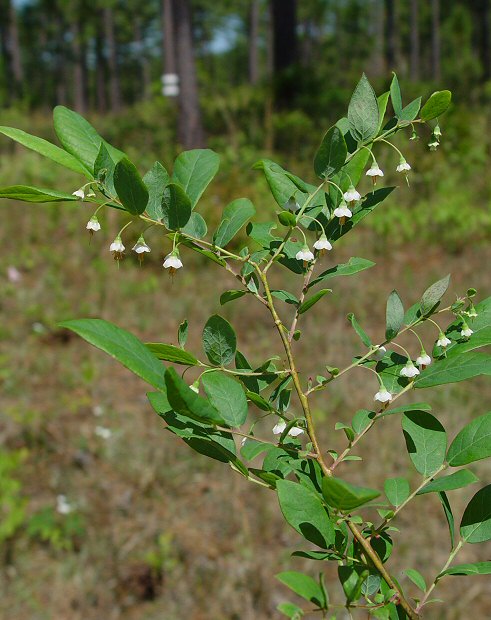Vaccinium stamineum L.
Deerberry

Native
CC = 6
CW = 3
MOC = 38
© DETenaglia
Vaccinium stamineum L.Deerberry | |
 |
Native CC = 6 CW = 3 MOC = 38 |
© DETenaglia |
|
Family - Ericaceae Habit - Shrub, to 2 m tall. Stems - Bark gray to brown, relatively smooth, peeling in thin, papery strips with age. Twigs glabrous to less commonly moderately hairy, green to yellowish green, becoming brown with age.
Leaves - Alternate, simple, sessile or short petiolate. Blades 10-95 mm long, 8-30 mm wide, elliptic to oblanceolate, the tip usually sharply pointed, the margins entire or finely and indistinctly toothed, sometimes slightly curled under, otherwise hairy, the upper surface glabrous or sparsely to moderately hairy along the midvein, occasionally slightly glaucous, not or only slightly shiny, the undersurface dull, glabrous or sparsely hairy, light green, occasionally somewhat glaucous. Inflorescences - Racemes or panicles, with leaflike bracts present at the base of each flower stalk, these 6-18 mm long, 2-5 mm wide. Flower stalks 4-12 mm long, with an inconspicuous joint at the junction with the flower.
Flowers - Calyx lobes 1.0-2.5 mm long, hairy along the margins, usually not glaucous. Corollas 4-6 mm long, 3-5 mm in diameter, bell-shaped, white, often purplish-tinged, lobed to about the midpoint, the lobes loosely ascending to more or less spreading. Stamens strongly exserted, with 2 yellow spurs at the filament-anther junction, these much shorter than the anther tubules, the filaments flattened, sometimes hairy, the anthers tapered to tubules 3-5 mm long. Styles 5-8 mm long, strongly exserted.
Fruits - Berries 6-14 mm in diameter, blue and often glaucous, not shiny, not tasty. Flowering - April - May, occasionally reblooming October - November. Habitat - Forests, glades, ridges, bluffs, in pine-oak or oak-hickory woods on acidic substrates. Origin - Native to the U.S. Lookalikes - V. pallidum, V. arboreum. Other info. - This shrubby species occurs in Missouri almost entirely within the southern 1/2 to 1/3 of the state. It also occupies a sharply-defined range within the eastern third of the continental U.S. Missouri's populations are near the northwestern extent of the plant's natural range. When in flower the plant is easily identified by its bell-shaped white flowers with strongly exserted stamens and styles. Identification at the vegetative stage is less obvious, as the plants can strongly resemble the more common V. pallidum. The key here is the leaf venation, which is finer and tighter in V. stamineum than in the other species. This can take some practice to discern confidently but is very evident when leaves of all three are available for inspection. The photo below illustrates this. Another clue is that the young stem tips of V. pallidum are densely covered with small, light-colored dots, a feature which is missing in V. stamineum.
Photographs taken at the Weymouth Woods Sandhills Nature Preserve, NC., 4-27-03 and at Fort Benning, GA., 5-6-05 (DETenaglia); also at Hickory Canyons Natural Area, Ste. Genevieve County, MO, 5-1-2010, and near Paddy Creek Campground, Texas County, MO, 5-13-2019 (SRTurner). |